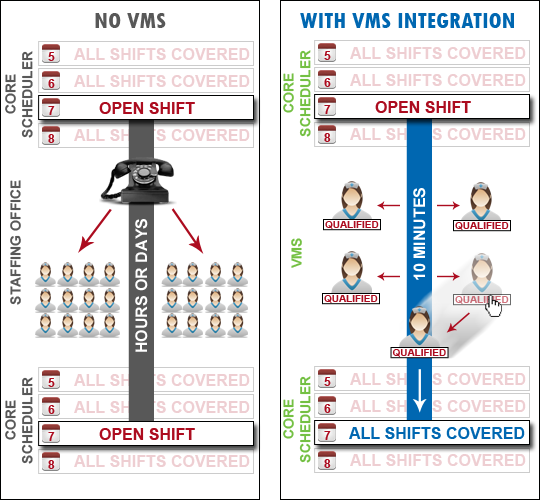Healthcare facilities have largely been adopting some form of core scheduling for quite some time now. A scheduling application makes it easier to manage the complexity of scheduling staff throughout an entire healthcare delivery organization. It’s pretty safe to say that in 2011, if you haven’t implemented some form of automation to schedule core staff, you’re a bit behind the curve.
But a common misconception that persists among health care leaders is that a core scheduling system solves all that ails the staffing department. However, when your scheduling system tells you that you need four more nurses in your ICU tonight but there are no available staff, your scheduling system can’t do much to help. It’s back to the phones.
The problem is that core scheduling apps aren’t really designed to book and manage the various forms of contingent labor that is typically deployed in this situation. Let’s face it, census, sickness, emergencies, change of plans and the general surprise that is our daily lives will never go away. And so, within organizations of any size, there is a constant need to efficiently and quickly react to these daily staffing crises.
Each hospital has its own way of handling scheduling gaps, among them:
- Internal resources pools
- Agency staff
- Travelers
- Part-time PRN staff
- Independent contractors
Together, these resources make up the strategic contingent workforce that ensures shifts are always covered. But the limited capabilities of most scheduling systems makes the execution of utilizing these resources inefficient and costly. Core scheduling systems simply aren’t designed to handle contingencies and if they are, they often do so at a high cost to overall productivity.
Staffing Euphoria: Integrate a Vendor Management System (VMS)
You don’t want to use agencies in the first place but you choose to have a manual process that is both time consuming and costly. Stop!! Use a VMS! It typically costs you nothing (yes, that’s zero) and any good one is being used by most of your vendors already.
If you really want to up your game, integrate your core scheduling with a vendor management system (yes, like ShiftWise) and you get the best of both worlds. Now, when a shift needs to be filled, instead of dumping your shiny new scheduling application for a good old-fashioned phone call and wild goose chase, you simply rely on an integrated solution that sends the data about the open job from your core app to your VMS. With a couple of clicks rather than a round of phone calls to various agencies, the opening can be filled.
What to expect from an integration
First of all, it’s not that difficult to accomplish. In a world where systems can communicate over the web with a standard language (.xml), getting two systems to communicate is, well, easy. And, integrating your core scheduler has benefits beyond seamlessly filling a shift. It significantly improves your reporting and insight into costs, hours worked, overtime and more. Even better, an integration further streamlines the time approval and agency payment eliminating the annoyingly disjointed process when using paper time sheets and invoices.
The end result is a simple and efficient process that results in cost savings, time savings and invaluable data to analyze your productivity. While there are many, here are a few of the main benefits of a VMS integration with your core scheduling system:
- Open shifts in your schedule are automatically communicated (email and/or text) to your contracted agencies
- All of your unit and facility requirements are automatically associated with orders in your VMS so only staff that meet your unique requirements or “match” are able to be submitted for consideration by your agencies
- When a staff member is booked in your VMS, the name of the person automatically populates into your schedule
- Any cancellations in your scheduling system are cancelled in your VMS and vice versa
- Manager approved time in your schedule or timekeeping system is exported to your VMS for agency time approval
- Consolidated billable invoice data is imported back into your scheduling system for productivity and cost tracking
If your goal is to become completely automated in your staffing operations, a VMS system is a must. Integrating your VMS with your scheduling system further improves efficiency and will make you a superstar. If you’re still not automated when using temporary labor because “we’re getting rid of agency” it may be time to reevaluate the merits of that argument.
When you want to cut back on family vacations to save some money do you use the phone to call up airlines and hotels to book your travel? Of course not, you book online. So why would you NOT use a Vendor Management System? I’ve never really heard a good reason but my ears are always open.
 See demo
See demo
